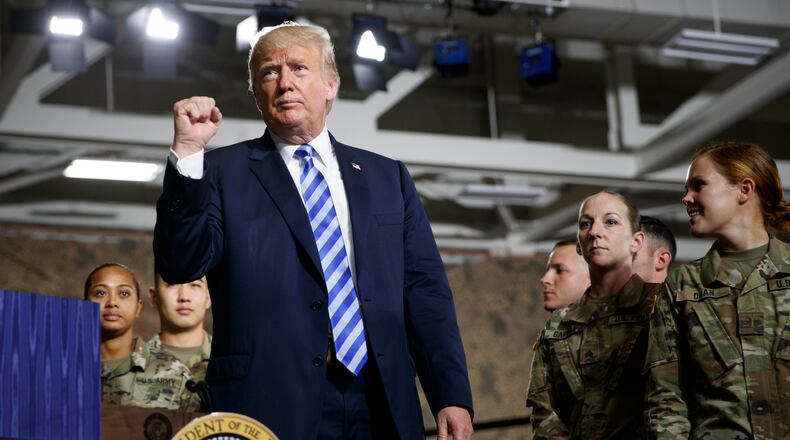Trump signed off on the legislation during a visit to the U.S. Army’s Fort Drum in upstate New York.
» RELATED: Wright-Patt creates group to investigate active shooter scare
NASIC will receive an initial appropriation of $61 million so construction can begin in fiscal year 2019. The U.S. Army Corps of Engineers plans to award the full contract by spring 2020, according to the agency. The construction period would likely be two and a half years.
The intelligence agency analyzes adversaries’ air, space, and cyber threats, such as ballistic missile capabilities, and provides findings to the nation’s political and military leaders.
“This bipartisan defense law supports the critical mission of NASIC and Wright-Patterson Air Force Base and authorizes the necessary funding to begin the modernization effort so that they can continue their important work,” Sen. Rob Portman, R-Ohio, said in a prepared statement. “These new facilities are critical for NASIC to fulfill its increasingly important intelligence analysis mission for our Air Force and national policymakers, and I applaud the president for signing it into law.”
The expansion will likely mean more jobs at NASIC, Rep. Mike Turner, R-Dayton has said, but he didn’t know how many the agency might add. As national decision makers and others have demanded more intelligence, NASIC’s workforce has increased by about 1,500 employees, or 100 a year between 2000 to 2015, according to the agency.
Turner and Sen. Sherrod Brown, D-Ohio, worked on the final version of the bill together in conference committee and celebrated its completion with a gathering at the Pentagon Club in Beavercreek last week.
» RELATED: Space Force proposal could impact Wright-Patt’s NASIC
“The bottom line to this celebration is not only are we a team as a community, we’re also a team on the federal level,” Turner said.
The $716-billion bipartisan spending plan, approved by the Senate in June in an 85-to-10 vote, represents an $82 billion increase over the current year. The 2019 figure is one of the biggest defense budgets in modern American history, despite concerns from some economists and lawmakers about the rising federal deficit.
The military has called the additional funding necessary to improve the response to international crises. About 17 percent of the $4 trillion U.S. federal budget goes to the military, according to the Congressional Budget Office.
The NDAA provides more than $1 billion toward research and development programs for the Air Force Research Lab at Wright-Patt. The NDAA will include $335.8 million to address issues of toxic chemicals from getting into local water supply at Air Force bases.
Last week, Vice President Mike Pence announced plans to create a Space Force by 2020 but the law provides no money for the potential sixth branch of the military. The NDAA does however authorize the military parade Trump has said he wants in Washington in November.
Military pay raise, other issues
Along with funding for NASIC and AFRL, the bill addressed a number of other pressing issues for the U.S. military.
One of the more lauded parts of the defense bill is a raise it will give service members.
» RELATED: Wright-Patt to get $182M for NASIC expansion: 5 things to know
Members of the armed forces are set to get their biggest raise in nine years, thanks to the defense law. It provides a 2.6 percent raise to the military.
“I will always work to make sure Ohio and its workforce have the resources needed to continue their important work of defending national security and keeping Americans safe,” Brown said.
The law also weakened a bid to clamp down on Chinese telecom company ZTE.
It means ZTE, a company found guilty of selling U.S. goods to Iran in violation of sanctions, will duck Commerce Department penalties that bar U.S. companies from doing business with it, according to The Washington Post. U.S. and Chinese officials had said those penalties would effectively put ZTE out of business.
The defense law allows Trump to waive sanctions against countries that bought Russian weapons and now want to buy U.S. military equipment. It also addresses child-on-child sexual assault at U.S. military bases worldwide. The issue was revealed this spring in an Associated Press investigation.
FIVE FAST READS
• Trump’s Space Force proposal could impact NASIC at Wright-Patt
• WATCH: Police body camera footage shows chaos at UD on St. Patrick’s Day
• Wright-Patt hospital leader: Teamwork ‘saved lives’ during shooter scare
• New furniture store to open location at two Dayton-area malls
• State suing Dayton company for ‘shoddy work
THANKS FOR READING
The Dayton Daily News is committed to bringing you independent, in-depth local stories. Help support our journalism by signing up for a print or digital subscription.
